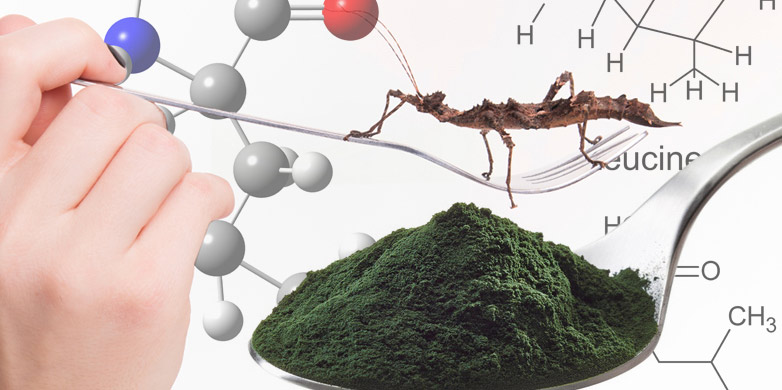Prospecting for Sustainable Proteins
Proteins are an essential part of a healthy diet, but supplying sustainable and sufficient high-quality protein is increasingly challenging. This is due to population growth, changing dietary patterns in favour of meat on the demand side, and a problematic reliance on unsustainable production on the supply side.
One doesn’t have to be a clairvoyant to see that the world population won’t be able to sustain its current feeding pattern in the long run. One billion people worldwide suffer from inadequate protein intake, some of them in western countries. Globally, roughly two-thirds of the proteins in human diets are plant-based, and one third is from animal-based sources; in North America this ratio is reversed [1]. Although animal source foods provide high-quality protein, many production systems are associated with social, ethical and environmental concerns, such as working conditions, animal welfare, or a substantial ecological footprint and greenhouse gas emissions. It’s clear that we need to develop ecologically and socially sound alternatives that provide a nutritious, healthy and affordable protein diet. But how?
Improve what we have
There are a range of options for making the existing animal source protein value chain more sustainable. One way includes finding alternatives for animal feed that are not grain-based, for instance by upgrading by-products that can be used as protein sources, e.g. utilizing residual press cakes from oil production. Currently Europe imports massive quantities of soy from abroad to feed our livestock.
On the other hand, we should also pay attention to further developing alternative sources from well-known, but often neglected, plant proteins. Pulses are the most prominent example, and the UN General Assembly has declared 2016 the International Year of Pulses [2] (see also this post). The challenge with pulses lies in creating products that fit modern lifestyle demands, particularly regarding taste, texture and preparation time. And this may require the redesign and optimization of processing strategies.
Insects as new sources
There is also a range of new protein sources with great potential. Currently, insects are being widely discussed, given the vast variety of edible species, the high-quality protein they offer and their resource-efficient production (see also this post). In many regions of the world, insects are traditionally used as both feed and food. In western cultures, on the other hand, insects are associated with pests and diseases, and consumer acceptance of insects is still low. A number of start-ups and companies that have reared insects for biological pest control are already positioned to enter the market and provide insects for human consumption. However, the legal framework in many countries, including Switzerland, does not yet allow insects as food or animal feed.
Cultivating algae on non-arable land
Even greater potential might lie in algae as a protein source. Algae are very rich in high-quality protein and in micronutrients or polyunsaturated fatty acids. Academics and industry are researching and developing innovative algae cultivation systems and downstream processing, in order to design efficient and sustainable processes that avoid waste and exploit the full nutritional potential. The focus is clearly on production efficiency to enable a cost-effective and affordable raw material supply, and on gentle downstream techniques for the release of sensitive ingredients. Algae could grow on non-arable land within respective photo bioreactors, consuming only CO2, light and some recycled fertilizers. However, due to fluctuating climate conditions over the year in some regions, only highly optimized cultivation systems would be viable.
Looking closely into life cycles
When considering options for future proteins, we need to keep in mind that alternative and novel proteins are not, by definition, more sustainable than existing proteins. A careful assessment of all the stages involved, and a life cycle analysis that considers nutritional and social issues in addition to environmental ones are essential. Connected biorefinery approaches within these innovative value chains assure the sustainable material and energy utilization by applying combined bioprocesses. These models produce zero waste and valorize all streams, with an optimal carbon sequestration into proteins, secondary products, fuel, soil and organic products.
The mix will matter
To be marketable and economically viable, innovative solutions based on technological progress need to consider the broader social, legal, political and economic framework. A solution can only be sustainable if it is culturally acceptable. Ultimately, any new product – whether based on proteins from algae, insects or pulses – must taste good, be easy to prepare and easy to eat.
There is no single sustainable protein source for the future. No doubt we need a combination of options, as well as a change in dietary habits towards a more diverse diet that includes a mixture of proteins from different sources.
Anna Katarina Gilgen wrote this blog together with Prof. Alexander Mathys and Michelle Grant.


